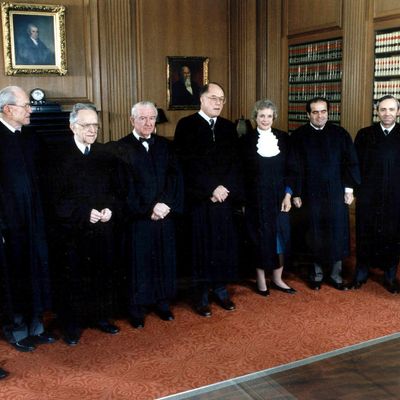
After today’s Supreme Court oral arguments in Dobbs v. Jackson Women’s Health Organization, it seems a lot of the mystery surrounding the Court’s direction on abortion rights has been reduced to a matter of details and exact timing. Intelligencer’s Irin Carmon explained that while Chief Justice John Roberts flailed around a bit, expressing the desire for some kind of compromise, a solid bloc formed by longtime anti-abortion justices Clarence Thomas and Samuel Alito and fortified by Donald Trump’s three appointees (justices Neil Gorsuch, Brett Kavanaugh, and Amy Coney Barrett) pretty clearly signaled an impatience with any temporizing:
There had been some pre-argument rumblings that Barrett and Brett Kavanaugh might defect, perhaps forming a bloc with Roberts to find some middle ground like the last time the court considered overturning Roe in 1992’s Planned Parenthood v. Casey. On Wednesday, neither Barrett nor Kavanaugh seemed inclined to disappoint the movement that put them on the Court.
In a nutshell, that sums up the long road back that the anti-abortion movement has trod over the past 29 years. In 1992, all signs pointed to a reversal of Roe v. Wade when a case testing certain abortion restrictions enacted by the State of Pennsylvania arrived at the Court. It appeared the movement’s marriage of convenience with the Republican Party (forged soon after Roe and solidified in 1980 when the Republican national platform blasted reproductive rights and endorsed a constitutional amendment banning abortion nationally) would bear fruit. At that time, eight of the justices had been appointed by a Republican president, and the only Democratic appointee (Byron White) was one of the original dissenters in Roe. Of the Republican appointees, moreover, one was Roe dissenter Chief Justice William Rehnquist, and five others (Sandra Day O’Connor, Antonin Scalia, Anthony Kennedy, David Souter, and Thomas) had been placed on the Court by the strongly anti-abortion presidents Ronald Reagan and George H.W. Bush. It looked close to a slam dunk.
But then it wasn’t. As Justice John Paul Stevens (a Ford appointee and Roe defender) later revealed in his 2019 memoir, a preliminary-draft opinion circulated by Rehnquist that overturned Roe got five votes. But during the long period of time before the decision was formulated and announced, Reagan appointee Kennedy flipped, succumbing to a plea from O’Connor and Souter to help them find a solution that would make state restrictions like Pennsylvania’s constitutionally acceptable without the disruptive counterrevolution that reversing Roe would represent. This development surprised the suddenly displaced anti-Roe majority, and then the country, as the Washington Post’s Robert Barnes recalled later:
The decision was a shock. Kathryn Kolbert, who argued the case for challengers of the restrictive Pennsylvania law, said recently it took her several hours to realize she should consider the ruling a victory. It upheld three of the four contested provisions, including a 24-hour waiting period and a requirement that minors have the consent of a parent or judge, and struck only the one requiring a woman to notify her husband before receiving an abortion.
“Shock” was an understatement for what excited anti-abortion activists experienced once the decision sank in, as Slate’s Mark Joseph Stern observed just prior to the Dobbs oral arguments this week:
Casey provoked a sense of betrayal, if not outright trauma, within the conservative legal movement. It prompted GOP attorneys to develop a more sophisticated vetting process for judicial nominees under the slogan “no more Souters.” Potential Supreme Court justices are now carefully screened for their anti-abortion bona fides with thinly veiled questions about “unenumerated rights” and “substantive due process.”
This won’t-get-fooled-again sentiment culminated in the implicit deal struck between the anti-abortion movement (including its conservative Evangelical and traditionalist-Catholic religious sponsors) and one Donald J. Trump in 2016. As he sought to consolidate his control of the Republican Party following his hostile takeover of the GOP in the presidential primaries, he violated all the rules of decorum by flatly promising to appoint only Supreme Court justices who would overturn Roe. Of equal importance, he published (and regularly revised) a list of potential justices from which he would choose, giving anti-abortion activists plenty of time to vet them. And most important, once he was elected, he turned over his judicial-vetting operation to the conservative legal warriors of the Federalist Society (and, to some extent, the Heritage Foundation).
This transactional arrangement gave anti-abortion activists the confidence to support Trump’s Court appointees without qualification and, just as important, to tolerate the evasions and deceptions they performed on matters involving reproductive rights to get through difficult confirmation hearings. And as the Court began to shift in a more conservative direction on this and related issues (such as religious-liberty exemptions), the Trump–conservative-Christian alliance grew stronger and more pervasive, to the point where today, defense of Trump’s Big Lie (and his thousands of little lies) has become a religious precept for many activists who appreciate the promises he kept to them.
A reversal of Roe would mean terrible things for those subjected to new, punitive anti-abortion laws around the country. It would also be another building block for Trump’s plan for returning to office in 2024, helping to strengthen his grip on a party that is, in turn, in the firm grip of the anti-abortion movement. And Trump may rightly be relieved by signs that his Court appointees won’t backslide on abortion. Any more betrayals by jurists appointed by Republican presidents may give the anti-abortion movement grounds for divorce.






























